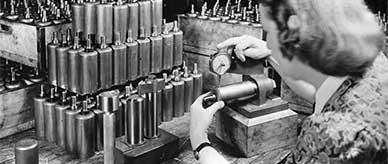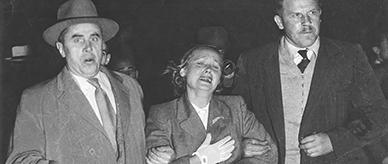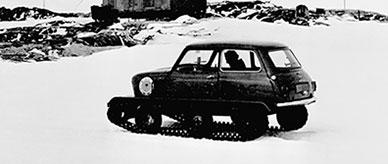
Transcript
Narrator: Sensors received a final check using a hydrogen light source rich in ultraviolet. The space between was flushed with nitrogen gas to prevent oxygen absorption. The radar transponder received a final check. Finally, the covers were fitted, the nose-cone was screwed down and WRESAT was ready. It was then taken to the launching area for mating to the rocket.
Here, with great care, to the relief of some and the confusion of the sceptics, it mated up perfectly and the whole assembly was ready for launching.
Erection was completed, the umbilical cord was attached. Through this cord, monitoring functions were maintained and power was supplied to ignite the rocket engines. In the nearby control van, missile functions were checked. When all was well the countdown began.
The optical tracker had a hazy view of the launcher scene due to the high ground temperature. As the countdown proceeds the heater–cooler drop tank is shed.
Light up.
Lift off.
[END]
About this record
This clip, from a 16 millimetre colour documentary produced by the Department of Supply’s Weapons Research Establishment Film Unit, is an audiovisual record of the Weapons Research Establishment Satellite (WRESAT) Project. The clip shows the launch of the first Australian scientific satellite from the Woomera Rocket Range in South Australia on 29 November 1967. Researchers conduct final checks of sensors and assemble the WRESAT flight nose-cone. The satellite is then transported to the launching pad, attached to a United States Project SPARTA launch vehicle, erected and fired into an elliptical polar orbit.
Educational value
- This clip shows the successful launch of WRESAT, the first Australian-made satellite to orbit Earth. The success made Australia only the fourth nation in the world, after the Soviet Union, the United States and France, to build and launch a satellite from its own soil into orbit. WRESAT was a joint project between the United States Department of Defense and the United Kingdom–Australia Weapons Research Establishment (WRE), based at the University of Adelaide and at Salisbury in South Australia.
- Built in less than a year, the 45-kilogram WRESAT was designed to measure solar radiation and the temperature and density of Earth’s upper atmosphere. It also had a small onboard telescope to measure Earth’s ultraviolet halo. With only batteries to power it, WRESAT operated for a very short time but transmitted a significant amount of scientific data. It burned up after re-entry on 10 January 1968. The WRESAT Project made a substantial contribution to satellite and missile research and established, albeit briefly, Australia’s satellite capability.
- The clip is evidence of Australia’s entry into the Cold War ‘space race’ between the Soviet Union and the United States. After the launch of the first satellite, Sputnik 1, by the Soviet Union in October 1957 the United States sought to gain supremacy in space technology. In 1960, a formal agreement between the Australian and United States governments brought Australia into the ‘race’, helping the nation to develop expertise in space research.
- This clip shows the second attempt to launch the satellite after the heater–cooler drop tank had failed to detach from the missile during the first attempt the day before, on 28 November. Due to the extreme surface temperatures at Woomera, a heater–cooler drop tank was attached to the WRESAT to regulate its temperature prior to lift-off. In this clip, the heater–cooler drop tank is successfully shed during countdown, allowing the satellite to fire into orbit.
- Woomera Rocket Range, which is shown in this clip, was established under the Joint United Kingdom–Australia Long Range Weapons Project (1946–80) and has been used for atomic weapons testing, satellite launches and for tracking spacecraft, including the Mercury manned mission (1958–63).
Acknowledgments
Learning resource text © Education Services Australia Limited and the National Archives of Australia 2010.
Related themes
Need help with your research?
Learn how to interpret primary sources, use our collection and more.



